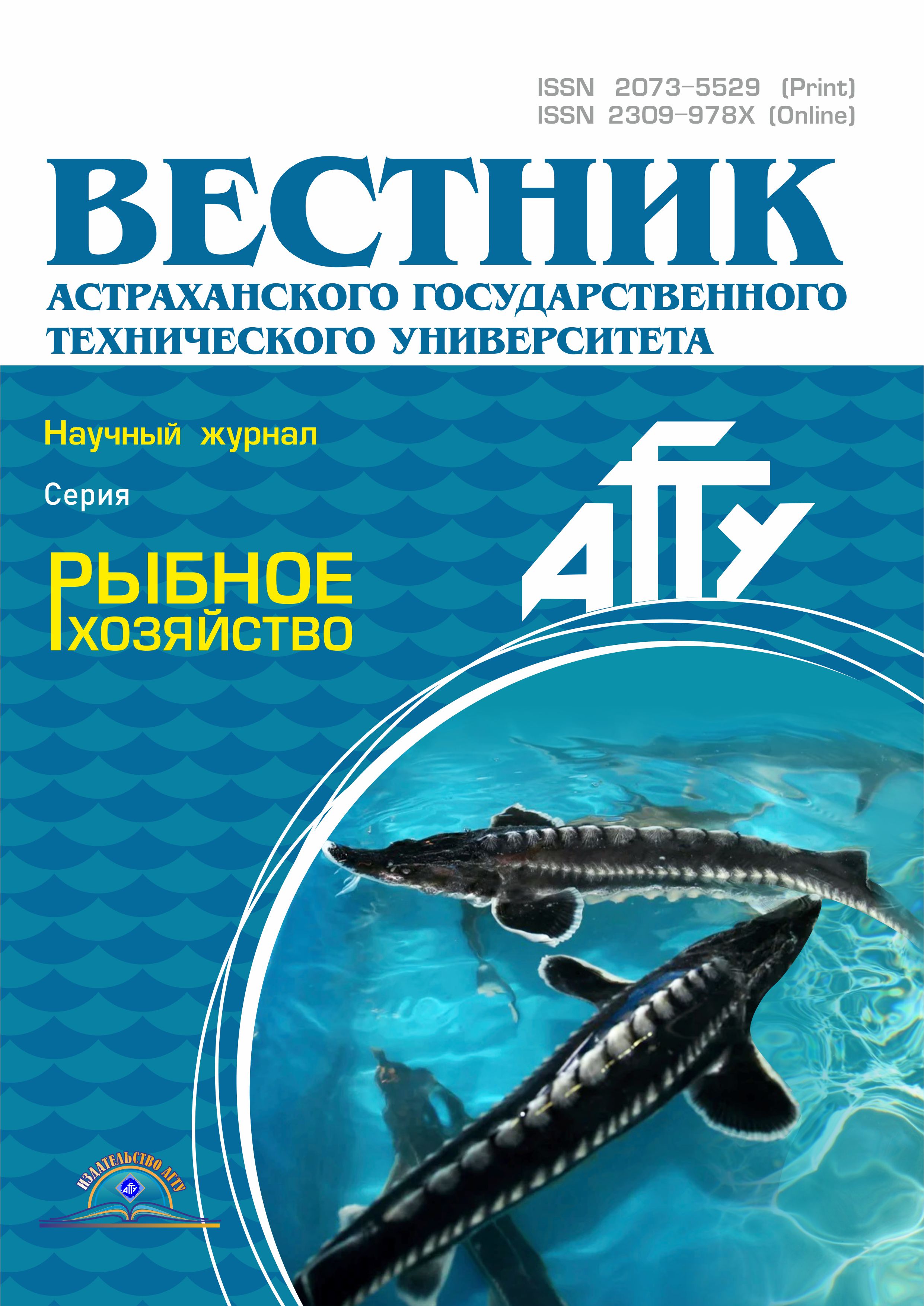ГРНТИ 34.39 Физиология человека и животных
ГРНТИ 62.13 Биотехнологические процессы и аппараты
ГРНТИ 69.01 Общие вопросы рыбного хозяйства
ГРНТИ 69.25 Аквакультура. Рыбоводство
ГРНТИ 69.31 Промышленное рыболовство
ГРНТИ 69.51 Технология переработки сырья водного происхождения
ГРНТИ 87.19 Загрязнение и охрана вод суши, морей и океанов
The aftereffects of a typical geomagnetic storm (the duration 24 h, in the frequency range 0-5 Hz) on the activity of glycosidase (maltase, amylolytic activity) in the intestine of a 4-month juvenile roach Rutilus rutilus (L.) have been studied. Embryos were exposed to geomagnetic storm 72 h later after fertilization. The amylolytic activity was determined by Nelson method and the maltase activity by the glucose-oxidase method. The level of glycosidase activity in juvenile roach under the impact of geomagnetic storm was significantly lower than that in controls. Temperature characteristics of glycosidase in fish of the experimental and the control groups are similar. Temperature optimum of amylolytic activity was observed at 40 ºC, the temperature optimum of maltase was found at 60 ºC. The E act values of maltase at the temperature 0-30 °C are similar in both groups of yearlings. The E act values of amylolytic activity at feeding temperature 10-20 °C were significantly lower (the efficiency of the process is higher) than at lower temperatures in both groups of yearlings.
рыбы, плотва, пищеварительные гликозидазы, амилолитическая активность, мальтаза, магнитная буря
1. Krylov V. V., Zotov O. D., Klain B. I. et al. An experimental study of the biological effects of geomag-netic disturbances: The impact of a typical geomagnetic storm and its constituents on plant and animals. J. At-mospheric and Solar-Terrestrial Physics, 2014, vol. 110-111, pp. 28-36.
2. Talikina M. G., Krylov V. V., Iziumov Iu. G., Chebotareva Iu. V. Vliianie tipichnoi magnitnoi buri na mitoz zarodyshevykh kletok i razmerno-massovye pokazateli predlichinok plotvy (Rutilus rutilus L.) [The efect of a typical magnetic storm on mitosis in the embryo cells and the length and weight of roach (Rutilus rutilus L.) prolarvae]. Biologiia vnutrennikh vod, 2013, vol. 6, no. 1, pp. 48-52.
3. Krylov V. V., Chebotareva Iu. V., Iziumov Iu. G., Zolotov O. D., Osipova E. A. V. Deistvie tipichnoi magnitnoi buri na rannii ontogenez plotvy Rutilus rutilus (L.) [Effects of an induced magnetic storm on the early ontogenesis of roach Rutilus rutilus (L.)]. Biologiia vnutrennikh vod, 2010, vol. 3, no. 4, pp. 356-359.
4. Golovanova I. L., Iziumov Iu. G., Chebotareva Iu. V., Talikina M. G. Otdalennye posledstviia razdel'nogo i sochetannogo vliianiia khlorofosa i peremennogo elektromagnitnogo polia v period embriogeneza na effektivnost' gidroliza uglevodov u segoletkov plotvy [Long-term effects of separate and combined effect of chlorophos and alternating electromagnetic field during embryogenesis on the efficiency of hydrolysis of carbohydrates in roach fingerlings]. Toksikologicheskii vestnik, 2006, no. 5, pp. 34-38.
5. Golovanova I. L., Filippov A. A., Krylov V. V., Chebotareva Iu. V., Iziumov Iu. G. Deistvie magnitnogo polia i medi na aktivnost' gidroliticheskikh fermentov u segoletok plotvy Rutilus rutilus [Effect of a magnetic field and copper upon activity of hydrolytic enzymes in roach (Rutilus rutilus) underyearlings]. Voprosy ikhtiologii, 2013, vol. 53, no. 3, pp. 225-230.
6. Ugolev A. M., Iezuitova N. N. Opredelenie aktivnosti invertazy i drugikh disakharidaz [Determination of the activity of invertase and other disaccharidases. Issledovanie pishchevaritel'nogo apparata u cheloveka [Study of the Digestive Tract of Humans]. Leningrad, Nauka, Publ., 1969, pp. 192-196.
7. Ugolev A. M., Kuz'mina A. M. Pishchevaritel'nye protsessy i adaptatsii u ryb [Digestive processes and adaptation in fish]. Saint Petersburg, Gidrometeoizdat, 1993. 238 p.
8. Korostelev S. G., Nevalennyi A. N. Vliianie temperatury na pishchevaritel'no-transportnuiu funktsiiu kishechnika karpovykh ryb [Influence of the temperature on food transporting function of the carp intestine]. Voprosy ikhtiologii, 2005, vol. 45, no. 2, pp. 225-235.
9. Kuz'mina V. V. Temperaturnye adaptatsii fermentov, osushchestvliaiushchikh membrannoe pishchevarenie u presnovodnykh kostistykh ryb [Temperature adaptations of enzymes participating in membrane-linked digestion in freshwater teleost]. Zhurnal obshchei biologii, 1985, vol. 46, no. 6, pp. 824-837.
















